Anna Geiger's Blog, page 7
July 14, 2024
What I wish I’d known about dyslexia
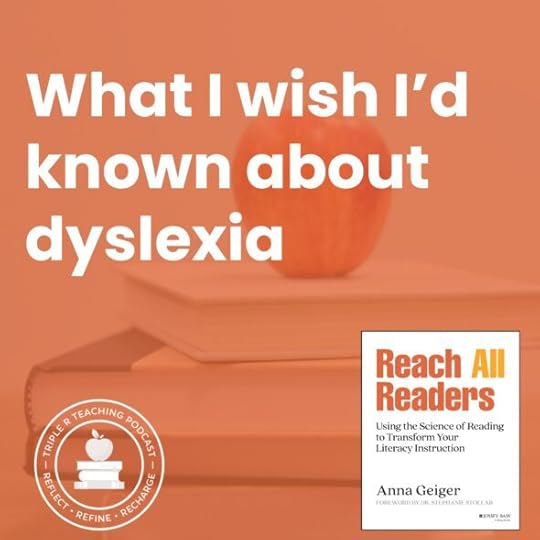 ��TRT Podcast 178: What I wish I’d known about dyslexia
��TRT Podcast 178: What I wish I’d known about dyslexiaAs a classroom teacher, I had heard of dyslexia – and that’s about it. In this episode I share what I wish I’d known about this common learning disability.��
Listen to the episode hereFull episode transcriptTranscript
Download
New Tab
Hello, Anna Geiger here, and my book is almost out! I'm so excited to be here with you and talk to you about dyslexia.
Before I do that, I want to share a quick endorsement for the book from the wonderful Virginia Quinn-Mooney. She's a moderator for What I Should Have Learned in College, she's the host of The Science of Reading Happy Hour, and she's an amazing teacher. She very generously read an advanced copy of the book, and she had this to say.
"My own science of reading journey is a lot like Anna's. I put a lot of hours into self-education. I wish this book was available when I started. It's established that students learn to read best when their teachers follow a strong scope and sequence and provide direct systematic instruction. Teachers learning about the science of reading need the same. Every page and chapter of 'Reach All Readers' equips teachers to best serve all students. As a SOR geek, I couldn't put it down. As a dedicated practitioner, I will return to it often."
Thank you so much, Gin, for reading the book and for sharing your feedback.
Let's talk today a little bit about dyslexia. When I was a classroom teacher, dyslexia was one of those words I'd heard of, but really didn't know anything about. I probably thought that kids with dyslexia see words backwards, which is a pervasive myth that just won't go away. I thought that dyslexia was rare, that it was something too complicated for me to understand and something I couldn't do anything about. I've learned a lot since then.
It's very interesting that many parents of kids with dyslexia have actually brought the science of reading into the mainstream in terms of people talking about it now, and people want to know what their schools are doing with explicit, systematic instruction. It's because many kids with dyslexia were not served by balanced literacy. Balanced literacy is not explicit and systematic enough for kids who are struggling with word recognition, specifically kids with dyslexia.
Dyslexia is a specific learning disability that leads to difficulties with accurate or fluent word recognition. Kids with dyslexia struggle with spelling and decoding, and they may struggle in spite of strong instruction.
Dyslexia occurs on a spectrum, so for some kids on the low end of the spectrum, they could get really good systematic instruction and you may not even know that they have dyslexia. Whereas on the other hand, we may have some students who receive very good instruction, but they still need extra support because they need a lot more repetitions and a lot more scaffolding and breaking things down.
There are different estimates for how prevalent it is. Dr. Sally Shaywitz, I think she goes up to 20%, and that's the highest one I've seen. I typically see more around 10%. It really depends on how you define it and where you put the cutoff points. But in general, let's say about 10% of our student population has dyslexia. Even 10% is a lot of kids. If you have a class of 20, then probability-wise, two of your students could have dyslexia.
As classroom teachers, we all have a responsibility to understand what dyslexia is. To be clear, dyslexia is neurobiological, so it's a brain-based learning disability. It is hereditary, so a lot of families where the parents had trouble reading, the kids have trouble reading, and maybe because they both have dyslexia.
Dyslexia is often called a surprising disability because we often see it in people who don't seem like they would have a reading problem. Their oral language may be very good. Their comprehension of what's read to them may be very good, but they struggle with getting words off the page.
When I look back to my teaching experience, I can definitely think of students like that. Unfortunately, I didn't know what dyslexia was and I didn't know how to help them, so instead I just had them read more. But these kids need a lot more than just reading more. They need explicit instruction in the code.
Something else I assumed as a teacher was that, well, if my students have dyslexia, that's not even something I can handle. There's nothing I could do about that. But when a teacher understands the science of reading - what we know from research about how we learn to read and what best practices are for the different key areas like phonemic awareness and phonics, and when a teacher understands the science of learning - how to break things down, how to avoid cognitive overload, how to provide scaffolding and feedback, then they are equipped to teach students with dyslexia.
Now, that does not mean that your regular classroom instruction will be enough. If they have more severe dyslexia, then they may need additional instruction in Tier 2 or Tier 3. They need more and better instruction. By better I just mean more repetitions, more explicit teaching, more breaking it down.
As a teacher, the more you understand about the science of reading and the science of learning, the better able you are to teach all the students in your classroom, including those who may have dyslexia.
My book "Reach All Readers" will equip you to reach all the readers in your classroom. I break down the research in all the key areas, provide practical ways to apply it, and then in the final chapter, chapter 11, I talk about MTSS. This is a system that you can use to determine what your students need to learn and when, and how you can support students, including those with dyslexia, who need extra help using school-wide systems for providing intervention.
I'm really excited that this book is almost out! If you haven't pre-ordered yet, you can do that through Amazon, Thriftbooks, Barnes & Noble, any other place that you can buy books online. Thanks so much for listening, and I'll talk to you next time!
That's all for this episode of Triple R Teaching. For more educational resources, visit Anna at her home base, themeasuredmom.com. And join our teaching community. We look forward to helping you reflect, refine, and recharge on the next episode of Triple R Teaching.
Scroll back to top
Sign up to receive email updates
Enter your name and email address below and I'll send you periodic updates about the podcast.
powered by
Pre-order my new book and get a FREE bonus!
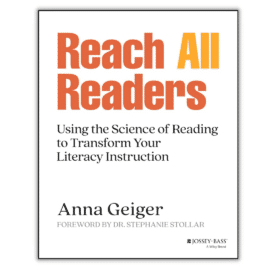
You’ll love this reader-friendly guide to the science of reading! Learn how to put the research into action so you can reach ALL readers. Pre-order before July 23 and get my Science of Reading Mini-Course – FREE!
PRE-ORDER NOW
The post What I wish I’d known about dyslexia appeared first on The Measured Mom.
July 7, 2024
A simple way to improve comprehension through writing
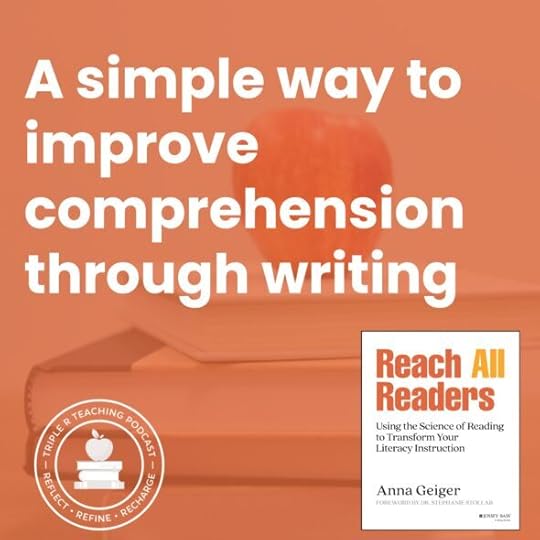 ��TRT Podcast 177: A simple way to improve comprehension through writing
��TRT Podcast 177: A simple way to improve comprehension through writingResearch tells us that students comprehend text better when they write about it. Here’s how to use a simple sentence expansion activity to improve comprehension.��
Listen to the episode hereFull episode transcriptTranscript
Download
New Tab
Hello, this is Anna Geiger from the Measured Mom, and this is almost the end of my short, to-the-point podcast episode series counting down to the release of my book "Reach All Readers" coming on July 23rd, 2024. Today I'm sharing a simple activity that you can do with your students to help them improve comprehension of a text through writing.
Before I get into it, I want to share a quick endorsement for the book from my friend, Lindsay Kemeny, whom you know as the author of "Seven Mighty Moves," an excellent, excellent book for teachers learning about the science of reading. She wrote, "Anna's clear and concise writing makes complex topics easy to understand. Packed with valuable info, her book is a go-to resource for elementary teachers and deserves a spot on your bookshelf." Thank you so much, Lindsay.
Now I'd like to go into this very quick, simple way that you can help your students understand the texts they read better.
Research tells us that writing about content material increases student learning in social studies, science, math, and language arts, and students comprehend text better when they write about it. But I want to be clear that you can start off by doing the writing yourself as long as your students are active participants in the process - they tell you what to write, they answer questions, they talk to a partner and then you call on someone.
When this is a process that you're all sharing, you can absolutely have them "write about the text" by helping you write about the text. It's all about the I Do, We Do, You Do model. Don't initially think you have to dive into having students do their own writing. Start by modeling it with them.
I did this activity recently with a group of third graders. We did a sentence expansion activity. First we choral read a passage about a particular topic. One was about the wolverine, another one was about mother pigs that live in the wild. After each passage, I presented a very short sentence related to the text, and then we expanded that sentence using what we knew from the text.
For example, with wolverines, my sentence was, "Wolverines hunt." Then I said, what kind of wolverines? They used information from the text to describe the wolverines, mostly by their color. Then I said, what do wolverines hunt? They looked at the text and they listed all the things that wolverines hunt. Then I said, how do they hunt? Again they referred to the text and we talked about how they hunt with their claws. Then we put all that information together into a single sentence. "Brown wolverines hunt mammals and other small animals using their claws." And that was it; it was just a very simple activity.
I was doing all the writing in front of them on a dry erase board, and every time I added new information, we would read the new sentence. First we read, "Brown wolverines hunt." Then we read "Brown wolverines hunt small mammals and birds." Then we read "Brown wolverines hunt small mammals and birds by using their sharp claws."
Gradually, you can have your students do the writing in pairs as you move around the room and support them, and eventually they can do this on their own. You would provide that simple sentence, then provide all those other sentences that they're going to have to answer to add more information, and then they can put it into a final complete sentence.
That's just one way that kids can respond to their reading in writing. There are so many other ways, and I share quite a few in chapter nine of my book, Linking Reading and Writing. You can pre-order the book "Reach All Readers" anywhere books are sold online, Amazon, Barnes & Noble, Target, B-A-M, or Thriftbooks. Thanks so much for considering, and I'll talk to you next time!
That's all for this episode of Triple R Teaching. For more educational resources, visit Anna at her home base, themeasuredmom.com, and join our teaching community. We look forward to helping you reflect, refine, and recharge on the next episode of Triple R Teaching.
Scroll back to top
Sign up to receive email updates
Enter your name and email address below and I'll send you periodic updates about the podcast.
powered by
Pre-order my new book and get a FREE bonus!

You’ll love this reader-friendly guide to the science of reading! Learn how to put the research into action so you can reach ALL readers. Pre-order before July 23 and get my Science of Reading Mini-Course – FREE!
PRE-ORDER NOW
The post A simple way to improve comprehension through writing appeared first on The Measured Mom.
June 30, 2024
A simple routine for teaching expository text structure
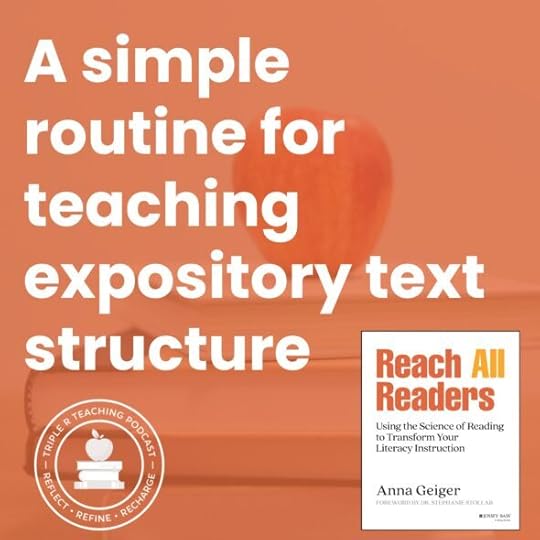 ��TRT Podcast 176: A simple routine for teaching expository text structure
��TRT Podcast 176: A simple routine for teaching expository text structureUse this simple routine to teach any of the expository text structures: sequence, description, cause and effect, compare and contrast, or problem and solution.
Listen to the episode here��Full episode transcriptTranscript
Download
New Tab
Hello, this is Anna Geiger from The Measured Mom, and this is the seventh in a series of short, to-the-point podcast episodes counting down to the release of my book, "Reach All Readers," coming soon on July 23rd, 2024. Today I'm sharing an excerpt from chapter eight, the comprehension chapter. I'm going to share a powerful routine for teaching text structure.
Before I do that, I want to share a quick endorsement from Brent Conway, Assistant Superintendent of Pentucket Regional School District. He generously read the book and offered this endorsement,
"Anna has been able to capture the complexities of implementing the science of reading and make it seem simple and tangible to any educator who wants to make a difference in the lives of their students. This will make a perfect book study text for schools and teachers across the country."
Thank you so much, Brent, for that very kind endorsement.
Now we'll get into text structure. We know there's narrative text structure, which has to do with understanding story elements, and then there's expository text structure where kids understand how informational text is organized.
When we think about expository text structure, there are five main kinds that we want to teach our students. These are description, sequence, cause and effect, compare and/or contrast, and then problem and solution.
In the book, I have a detailed table that lists all of those, describes them, includes possible signal words, gives you prompts that you can ask as you help students understand those structures, and also provides some graphic organizers.
Right now we're going to go into a routine that you can use to teach any of these text structures. I'm going to walk you through a text structure lesson that I recently gave to a group of second graders.
The teacher told me that one of the topics they'd been studying in science was animal habitats, so I wrote a passage about beavers and how they build their dams and lodges. This was organized with the sequence text structure because we went in order from first to last, including all the steps that they followed to build their lodges. I brought that to the class and we did multiple things with it.
First, I took it and I introduced it to them. I said, "Today you're going to learn a certain way that authors might organize their text, and this text structure is called sequence. You're going to read about the steps that beavers take to build their lodges from first to last."
Then we did a choral read of the text. We all read it together. You could also have students read it in pairs or choral read it in pairs.
After we were done reading the text, I had them identify the signal words. We walked through it and we found things like first, next, then, finally, and then they highlighted those in their passage.
The next thing we did was build comprehension, so I asked questions about the text. I actually was able to incorporate another strategy here, the QAR method, question-answer relationship, where you think about where the answers came from. So the answer could be right there in the text, or the answer could be something where you have to think and search and put pieces of information together. An answer could be author and me, where you think about what the author has shared and combine that with your own thoughts. Then finally, an answer could be on my own, where you're not even using the text to answer the question.
So I asked questions like, what's the first step when a beaver builds their home? What are other animals that put a lot of effort into building their homes? That would be an on my own, for example. I asked a question, what problem do you think that beavers' lodges can create for people who live in the area? That would be an author and me. They had to use the text, but they had to add to that what they already know.
As they answered those questions, we identified what types of questions they were. We didn't have time for this in our lesson, but if you're doing this with your students and you have more time, you could have them form questions about the passage to ask a partner, and then the partner could form a question to ask them.
The last thing we did was complete a graphic organizer together. I put a very simple sequence graphic organizer up on the screen, and they had a copy at their own desk. We walked through all the steps and we wrote those in the graphic organizer.
After we'd written each of the steps, we went back and added those signal words, and then we read it all as a whole paragraph.
That's a routine you can use to teach text structure. There's SO much more in my chapter on comprehension, including a great deal about sentence comprehension. I talk about the importance of building knowledge, but I also talk about the comprehension strategies that we know make the most difference.
If you'd like to pre-order the book, you can get it wherever books are sold, Amazon, Barnes & Noble, Target, Bookshop, BAM!, or Thriftbooks. Thanks so much for listening, and I'll talk to you next time!
That's all for this episode of Triple R Teaching. For more educational resources, visit Anna at her home base, themeasuredmom.com, and join our teaching community. We look forward to helping you reflect, refine, and recharge on the next episode of Triple R Teaching.
Scroll back to top
Sign up to receive email updates
Enter your name and email address below and I'll send you periodic updates about the podcast.
powered by
Pre-order my new book and get a FREE bonus!

You’ll love this reader-friendly guide to the science of reading! Learn how to put the research into action so you can reach ALL readers. Pre-order before July 23 and get my Science of Reading Mini-Course – FREE!
PRE-ORDER NOW
The post A simple routine for teaching expository text structure appeared first on The Measured Mom.
June 23, 2024
How to choose words for vocabulary instruction
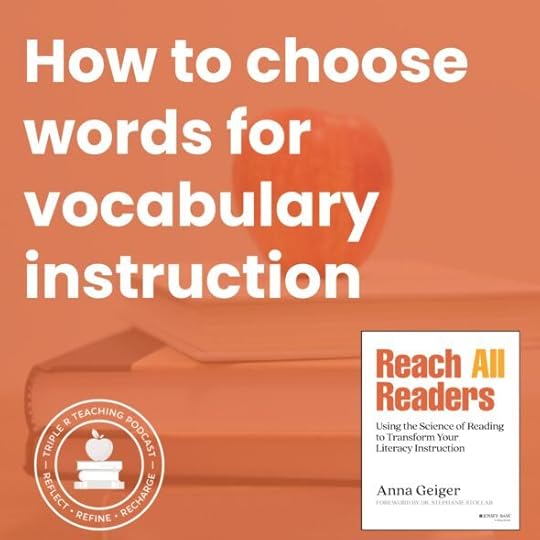 ��TRT Podcast #175: How to choose words for vocabulary instruction
��TRT Podcast #175: How to choose words for vocabulary instructionWe know it’s important to teach particular vocabulary words in depth – but how do we choose from the many thousands of words that students might encounter? These six questions will help you choose words for vocabulary instruction.
Listen to the episode hereFull episode transcriptTranscript
Download
New Tab
Hello! This is Anna Geiger from the Measured Mom, coming to you with a very short, to-the-point podcast episode that's part of a series that serves as a countdown to the release of my new book, "Reach All Readers," coming on July 23rd, 2024.
Before we get into it, here's an endorsement from the wonderful Margaret Goldberg, who is not only a brilliant teacher, but also an amazing writer and presenter, and she's the co-founder of the Right to Read project. She shared, "We've long needed 'Reach All Readers,' a book on effective reading instruction written for teachers by a teacher. Anna presents what she's learned about the science of reading and instruction in an accessible and useful text. You'll want to read it cover to cover, discuss chapters with colleagues, and hang on to it as a reference book." Thank you so much to Margaret Goldberg for that very kind endorsement. I have an incredible amount of respect for her and all the work that she does.
Today we're going to look very briefly at how to choose vocabulary words for instruction.
Vocabulary, of course, is the knowledge of words and their meanings, and meaningful vocabulary instruction involves discussions of words, using words in a variety of contexts, and teaching students to learn words on their own. I get into all of that in chapter seven, but for right now, we're just going to briefly look at how to choose words for in-depth instruction.
You may have heard of Beck and McKeown's three tiers of vocabulary words.
Tier 1 words are words that most kids know when they come to school, unless they're learning English. It's words like "ball, chair, play," and things like that.
The Tier 2 words are the words that are useful for in-depth instruction because they're words that kids are unlikely to learn on their own but are likely to encounter in text that they listen to or read.
Tier 3 words are also good for instruction, but maybe not as in-depth as in Tier 2 because they have limited use. They are for specific content areas. If you're teaching a unit on whales, Tier 3 words might include "baleen" or "plankton." They're good to know, but we tend to spend more time on those Tier 2 words.
So how do you choose Tier 2 words for instruction? There are different ways to do this. I had a podcast episode with Dr. Lorraine Hammond, and she has helped schools develop a whole-school vocabulary routine. They actually have lists of words that they have on a particular theme, and they just change them per grade. During a particular week, everybody's learning words from a particular theme. This is a really neat, effective way to build kids' vocabulary because you're building on what's been taught in previous grades.
If you do not have a whole-school approach to vocabulary instruction, you may want to choose your vocabulary words from the books that you read to your students or that they read. If the books that you're reading aloud do not have strong vocabulary words, you can add vocabulary words. Even if they're not in the text, you can teach a word that has to do with the topic of the text.
Let's say we're looking in the text and we're trying to choose some words to teach in depth. What types of questions should we ask ourselves?
Well, number one, is this a word that many of my students probably don't know? I know this is a really tricky one, and it really changes from class to class, so you really need to think about the groups of students in front of you.
Then you want to ask yourself, is this a word they're unlikely to learn on their own? In other words, it's probably not something they're going to hear in everyday conversation.
Next, is this a word that they're likely to encounter in text, whether I read it to them or they read it themselves? If you find a word that you didn't know the meaning of, it's probably not a word that you need to give explicit instruction on, because if you're an adult and you've never heard the word before, it's probably not one they're going to encounter very often.
Ask yourself, is this a word for which they understand the general concept? For example, the word "euphoric" means really, really excited. They know what really, really excited means. The word "melancholy" means a feeling of sadness. They know what sadness means. Choose words that they can understand as long as you give them a kid-friendly definition.
Is this a word that can be applied in many contexts? If it is, then you've multiplied the usability of this word.
Finally, can you teach other words in the same family? I used to think of word families as just "pat, mat, rat," the rhyming word families, but actually I've learned that there's so much more to that. If you had the word "adhere," for example, which means to stick to something, you could do "adhere, adherence, adhesive, adhered, adhering." So think about if there are other words you can also teach to get more bang for your buck.
Those were some questions to ask when choosing vocabulary words to teach in depth. There's much, much more to the vocabulary chapter, including lots of specific ways that you can help kids remember words for the future. You're invited to pre-order my book, "Reach All Readers," which you can get wherever books are sold. You can buy it on Amazon, Barnes & Noble, Target, Bookshop, BAM!, or ThriftBooks. Thanks so much for considering, and I'll talk to you next time!
That's all for this episode of Triple R Teaching. For more educational resources, visit Anna at her home base, themeasuredmom.com, and join our teaching community. We look forward to helping you reflect, refine, and recharge on the next episode of Triple R Teaching.
Scroll back to top
Sign up to receive email updates
Enter your name and email address below and I'll send you periodic updates about the podcast.
powered by
Pre-order my new book and get a FREE bonus!

You’ll love this reader-friendly guide to the science of reading! Learn how to put the research into action so you can reach ALL readers. Pre-order before July 23 and get my Science of Reading Mini-Course – FREE!
PRE-ORDER NOW
The post How to choose words for vocabulary instruction appeared first on The Measured Mom.
June 16, 2024
3 Powerful ways to build fluency with the whole class
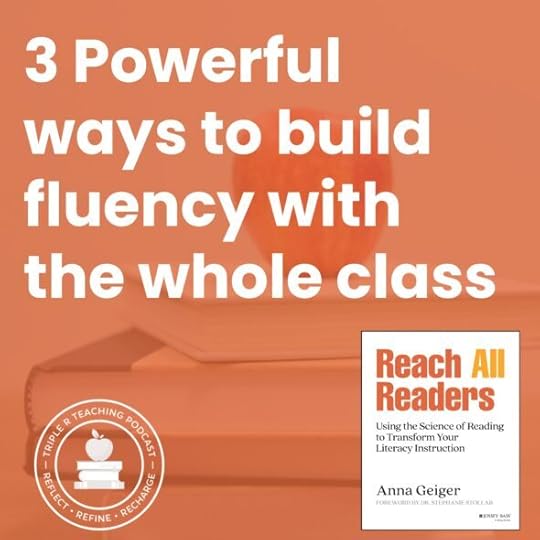 ��TRT Podcast #174: 3 Powerful ways to build fluency with the whole class
��TRT Podcast #174: 3 Powerful ways to build fluency with the whole classThese are simple and powerful fluency routines that you can use throughout the day!
Listen to the episode hereFull episode transcriptTranscript
Download
New Tab
Hello, this is Anna Geiger from The Measured Mom, and this is the fifth in a series of short, to-the-point episodes that are counting down to the release of my book, "Reach All Readers," on July 23rd, 2024. Today I'm sharing three powerful whole class fluency interventions.
Before I do that, I'd like to share a quick endorsement for the book from Faith Borkowsky. She's the founder of High Five Literacy and co-host of The Literacy View podcast. She wrote, "Anna Geiger doesn't just present the science, she equips educators with practical strategies and resources, translating them into actionable knowledge that can be readily applied in the classroom. Whether you're a seasoned teacher or just starting out, this book empowers you to become a more informed and effective practitioner. Aptly named, 'Reach All Readers' illustrates Geiger's knack for making the science of reading less science-y."
A big thank you to Faith for endorsing the book, and now we'll get into fluency which, according to Deb Glaser and Jan Hasbrouck, is "reasonably accurate reading at an appropriate rate with suitable expression that leads to accurate and deep comprehension and motivation to read."
Fluency is very important because it's the bridge between phonics and comprehension. But we can't fast-forward our way to fluency. It's very important to start with fluency at the letter sound and word level. By the middle of first grade or so when kids are reading connected text with reasonable accuracy, it's time to focus on text-level fluency.
In this episode, I'm going to look at three whole-class ways to build text-level fluency.
Probably the easiest is choral reading, when students read text together with you. This can be done so many times throughout the day. Whether it's choral reading vocabulary words, or choral reading a text that you're going to be analyzing the text structure of, or choral reading a math problem, you can do this all throughout your day.
Another great way to build fluency with the whole class is doing partner reading with paragraph shrinking. You want to pair students up, stronger readers with less strong readers. You could number your students, let's say from 1 to 24. The number 1 would be perhaps the lowest words correct per minute, and then the 24 would be the highest. Split your numbers in half and then line kids up, so student 1 would be with student 13 and so on. Of course, you would never reveal your numbering system to your students. You would just have each of them be a pair of a one and a two.
Get yourself some free passages from ReadWorks or kids could be practicing using decodable texts that they've had in their lesson. You can have the stronger reader begin by reading the text for about one to five minutes, and then the weaker reader reads the same text, even though it may take longer. Then you go back to the stronger reader, and again they can read for a certain period of time. After each paragraph, they're going to stop and summarize, and they can do that together where they name the most important who or what of the paragraph and the most important thing about the who or what. Then they use their fingers to help them put together a summary, an oral summary, that's ten words or less.
I recently did this with a group of second graders and it was amazing how quickly they caught on to this. I had printed a whole bunch of interesting passages from ReadWorks about different animals that were appropriate for a second grade group, and then after modeling it and showing them how to get started, they were on their own and I was walking around the room and supporting them. It's an excellent way to build fluency.
Finally, we have a fluency development lesson. I recently was able to do this with a third grade group. I chose a rather advanced poem that one of my team members wrote for our membership, it was about Katherine Johnson, and I put it up on a screen. We looked at some of the longer words and worked at decoding those. Then I read it a couple of times, the kids read it with me, and then they worked in pairs. One student read it to the other, and then the second student read it to the first student. Then we all did it together for an audience of other adults that were in the room. It was really neat to see how much their fluency improved from the first to the last reading.
Those are three whole-class ways to build text level fluency. You'll get a lot more about fluency in chapter six of my book, "Reach All Readers," which you can get wherever books are sold, Amazon, Barnes & Noble, Target, Bookshop, BAM!, and ThriftBooks. I hope you'll consider pre-ordering. The book is coming out on July 23rd, 2024. I'll talk to you next time!
That's all for this episode of Triple R Teaching. For more educational resources, visit Anna at her home base, themeasuredmom.com, and join our teaching community. We look forward to helping you reflect, refine, and recharge on the next episode of Triple R Teaching.
Scroll back to top
Sign up to receive email updates
Enter your name and email address below and I'll send you periodic updates about the podcast.
powered by
Pre-order my new book and get a FREE bonus!

You’ll love this reader-friendly guide to the science of reading! Learn how to put the research into action so you can reach ALL readers. Pre-order before July 23 and get my Science of Reading Mini-Course – FREE!
PRE-ORDER NOW
The post 3 Powerful ways to build fluency with the whole class appeared first on The Measured Mom.
June 9, 2024
Here’s what we do and don’t know about using decodable text
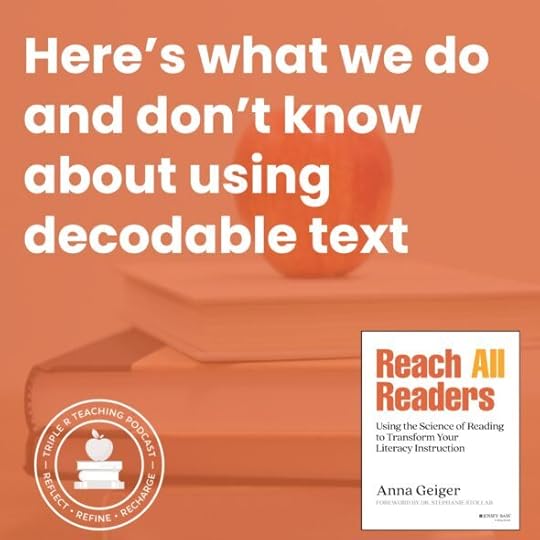 TRT Podcast #173: Here’s what we do and don’t know about decodable text
TRT Podcast #173: Here’s what we do and don’t know about decodable textWe know that it’s important to practice applying the phonics skills they’ve been taught, but what does research really say about using decodable text? What are questions do we still have?
Listen to the episode hereFull episode transcriptTranscript
Download
New Tab
Hello, this is Anna Geiger from The Measured Mom, and this is the fourth in a series of short, to-the-point episodes that are counting down to the release of my book, "Reach All Readers," on July 23, 2024. Today I'm sharing what we do and don't know about decodable text.
Decodable text can be sentences, a passage, or a book in which a majority of the words can be sounded out based on sound-spellings the reader has been taught. Decodable text may also be called phonetically-controlled text or accountable text.
Text is decodable from the point of view of the reader. For you and me, almost every text we encounter is decodable. For a child who is just learning to read, a decodable text will contain mostly CVC words.
The reason we use decodable text is because this kind of text allows students to apply their phonics knowledge by decoding words from left to right with attention to every letter. The more times students decode a word, the closer they get to recognizing it instantly as a sight word. In other words, the closer they get to orthographically mapping the word.
The reason that decodable text is getting so much attention in circles where people are attuned to the science of reading is because with balanced literacy, there was a heavy emphasis on using predictable leveled books with beginning readers. Those are the books that I used with my beginning readers, and I used to give these types of books away on my website.
What they did was require students to use the pictures or context to identify the words because they didn't have the phonics knowledge to read these longer words. The book might say, "I see a hippopotamus. I see a lion. I see an octopus," and the picture and the first letter would help them identify those words.
The big problem with those books is that they bypassed orthographic mapping. It's hard to map the sounds, letters, and meaning of a word if you're not even looking at all the letters of the word.
Another problem is that for some kids, it taught them to guess at words.
While the idea was that the more phonics knowledge you have, the more you apply, that doesn't always work for kids, and so many kids hit a wall as they get into second or third grade and have to read these longer books.
I think I'm speaking for a lot of people when I say I wish we had more research on decodable text. Let me give you a quick summary of what we know.
In 1985, Juel and Roper-Schneider conducted a study with first graders, and after receiving identical phonics instruction, one group read from a basal with more decodable text and the other read from a basal with a focus on high frequency words. The kids who read the more decodable texts were more likely to sound out words when reading. In other words, the text they were given to practice with led to a particular behavior when doing their reading.
A 2004 study found that average readers were more successful at reading decodable texts than text that was less decodable. Interestingly, in this study, the students with weaker reading abilities did not do as well with decodable text, but in discussing the study, it was thought that this was because they were not necessarily matched with texts that were decodable for them based on what they had learned.
There was a 2004 study in which at-risk first graders were tutored in either highly decodable or less decodable texts, and both of them received the same phonics instruction. The control group did not get tutoring. Both tutored groups showed improvement in their reading, but the decodability of the text did not seem to make a difference.
Some people use this study to question the benefits of decodable text, but I know Wiley Blevins has said that the decodable texts in this study were not very good.
We know that decodable texts should sound like we talk. They should be interesting. They should have a high level of words that have been taught. If the texts are strange or stilted, they're not going to serve their purpose as well.
A 2005 study gave phonics instruction to two groups of first graders. One group was given highly decodable text to read after instruction, and the other was given less decodable text. The students who read the highly decodable test applied their letter sound knowledge to a greater extent than the control group, and they were also more accurate in their reading. Again, the type of text you give students to practice affects their reading behaviors.
In 2005, Wiley Blevins conducted a study in which one group of first graders used decodable text for practice, and the other group read patterned and predictable text. The students who read the decodable text achieved higher scores on a word identification test, a phonemic awareness assessment, and a decoding assessment. They were also less likely to say that they didn't like reading.
There are a few more studies we have about decodable text. I've summarized them in my chapter on phonics, Chapter 5, but I also address that there are some questions we would like to have answered that are not answered.
We would like to know what is the ideal percentage of decodability of decodable text. Some people would say the text should be one hundred percent decodable as long as you have taught those high frequency words, but research doesn't say that. It doesn't give us a recommended percentage, nor does research say when is the appropriate time to help kids transition out of decodable text, whether that's for instruction or for independent practice.
We still have questions, but there's a lot we do know, so I think you're really going to enjoy the chapter about phonics. Not only do I go into quite a bit of detail about using decodable text, but I also include a very systematic, explicit phonics lesson, lots of charts, including a chart that shows the graphemes that we use in English from most common to least common, and a whole lot more. I hope you'll consider pre-ordering "Read All Readers."
Kate Winn, the brilliant teacher and host of IDA Ontario's Reading Road Trip Podcast, endorsed the book. She wrote this, "'Reach All Readers' is a gift for elementary teachers and their students. Anna Geiger deftly packs the what, why, and how of the science of reading into one user-friendly, empowering book that you'll want to keep coming back to again and again."
You can pre-order "Reach All Readers" wherever books are sold, on Amazon, Barnes & Noble, Target, Bookshop, BAM!, or ThriftBooks. Thanks so much for listening, and I'll talk to you next time!
That's all for this episode of Triple R Teaching. For more educational resources, visit Anna at her home base, themeasuredmom.com, and join our teaching community. We look forward to helping you reflect, refine, and recharge on the next episode of Triple R Teaching.
Scroll back to top
Sign up to receive email updates
Enter your name and email address below and I'll send you periodic updates about the podcast.
powered by
Pre-order my new book and get a FREE bonus!

You’ll love this reader-friendly guide to the science of reading! Learn how to put the research into action so you can reach ALL readers. Pre-order before July 23 and get my Science of Reading Mini-Course – FREE!
PRE-ORDER NOW
The post Here’s what we do and don’t know about using decodable text appeared first on The Measured Mom.
May 26, 2024
The most important things to remember when teaching phonemic awareness
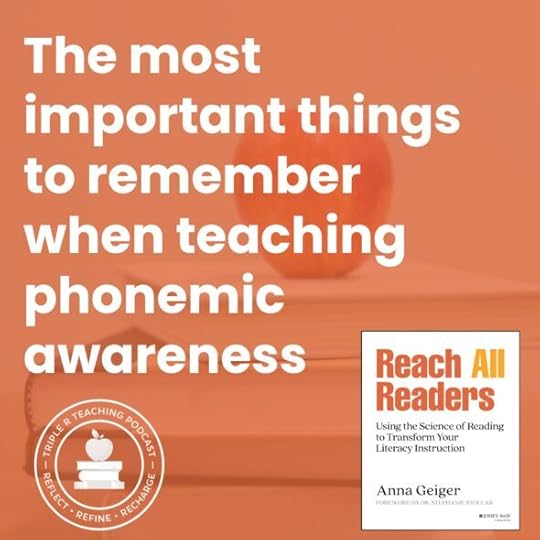 ��TRT Podcast #171: The most important things to remember when teaching phonemic awareness
��TRT Podcast #171: The most important things to remember when teaching phonemic awarenessPhonemic awareness can feel like an overwhelming topic … but you’ll find the most important things to remember in this 3-minute episode.��
Listen to the episode hereFull episode transcriptTranscript
Download
New Tab
Hello! This is Anna Geiger from The Measured Mom, and this is the third in a series of short, to-the-point episodes that are counting down to the release of my book, "Reach All Readers" on July 23rd, 2024. Today I'm sharing the most important things to remember when teaching phonemic awareness.
Phonemic awareness is the conscious awareness of individual units of sound in spoken words, and these units of sound are called phonemes. A phoneme is the smallest unit of sound within a spoken word that can distinguish one word from another.
The first important thing to remember is that of all the phonological awareness skills, phonemic awareness is by far the most important. While you may choose to teach other skills like rhyming, syllable counting, and onset-rime, there's no reason to delay the teaching of phonemic awareness. You don't need to teach those other skills before phonemic awareness. Phonemic awareness should be taught beginning in preschool.
The next thing to remember is that when doing phonemic awareness tasks, start with phoneme isolation, that's helping kids hear the initial, final, and medial sounds in words, in that order. Then move on to blending phonemes into words and segmenting words into phonemes. Blending is important for decoding and segmenting is important for spelling.
The third thing to remember is that you should incorporate letters into your phonemic awareness instruction as soon as you are able. Oral activities are useful before students know letter-sound correspondences, and they continue to be useful as transition activities and as quick phonics lesson warm-ups, but phonemic awareness instruction is most effective when letters are incorporated because it helps students learn the alphabetic principle that symbols represent units of sound.
Finally, phonemic awareness instruction is a means rather than an end. Phonemic awareness is not meaningful in and of itself; it only matters in the context of reading instruction, and that's why it's so important to incorporate letters into phonemic awareness instruction whenever possible. That's not turning phonemic awareness into phonics; it's adding phonics.
Phonemic awareness is chapter four in my book, "Reach All Readers," and within that chapter, I give specific lesson routines that will help you make the most of your phonemic awareness instruction. You can get Reach All Readers wherever books are sold, Amazon, Barnes & Noble, Target, Bookshop, BAM! or ThriftBooks. Thanks so much for considering, and I'll talk to you next time!
That's all for this episode of Triple R Teaching. For more educational resources, visit Anna at her home base, themeasuredmom.com, and join our teaching community. We look forward to helping you reflect, refine and recharge on the next episode of Triple R Teaching.
Scroll back to top
Sign up to receive email updates
Enter your name and email address below and I'll send you periodic updates about the podcast.
powered by
Pre-order my new book and get a FREE bonus!

You’ll love this reader-friendly guide to the science of reading! Learn how to put the research into action so you can reach ALL readers. Pre-order before July 23 and get my Science of Reading Mini-Course – FREE!
PRE-ORDER NOW
The post The most important things to remember when teaching phonemic awareness appeared first on The Measured Mom.
May 19, 2024
What does research say about oral language?
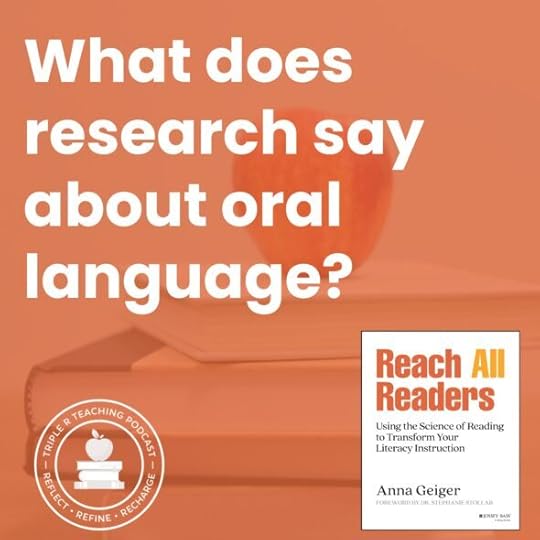 ��TRT Podcast #170: What does research say about oral language?
��TRT Podcast #170: What does research say about oral language?The Big 5 (phonemic awareness, phonics, fluency, vocabulary, and comprehension) get a lot of attention – but what about oral language? Oral language deserves attention because it is the foundation of both word recognition and language comprehension. In this episode I share a short summary of what research tells us about oral language and reading.
Listen to the episode hereFull episode transcriptTranscript
Download
New Tab
Hello! This is Anna Geiger from The Measured Mom, and this is the second in a series of short, to-the-point episodes that are counting down to the release of my new book, "Reach All Readers," on July 23rd, 2024. Today I'm sharing a research summary from chapter three, Oral Language.
We're all familiar with The Big 5: phonemic awareness, phonics, fluency, vocabulary, and comprehension, but what about oral language? It doesn't always get the attention it deserves.
Oral language is a complex system that is important for teachers to understand because oral language skills are the foundation for both word reading and language comprehension.
One thing I think you'll love about the book is that I have short research summaries in all the key areas, and in today's episode I'm going to share the research summary for oral language. When you receive the book, you'll get, of course, a list of references for all the points I'm about to share.
Number one, as I stated already, children's oral language skills are the foundation for both word reading and language comprehension, and that makes sense when you think about it, right? Obviously, when kids are trying to comprehend text, it's really important that they understand the language. But it's also important for word reading because if you're trying to decode a multisyllable word and you need to use set for variability to land on the correct pronunciation, you won't know if you're correct or not if you don't have that word in your oral language vocabulary.
We also know from research that children with reading problems often have accompanying oral language deficits.
We know that early oral language abilities help us predict later skills. In one study, poor comprehenders in fifth grade had deficits in oral language throughout early childhood. Kindergarten scores of oral language are highly predictive of their scores on reading comprehension and vocabulary in fourth and seventh grades.
Composite measures of oral language are the strongest predictors of word reading and language comprehension compared to studies that focus on a single predictor like vocabulary or grammar.
The good news is we can improve oral language skills. A focus on a range of oral language skills in preschool leads to improvements in oral language and spoken narrative skills.
Explicitly teaching word meanings through interactive read-alouds may help narrow the vocabulary gap among students.
A focus on building vocabulary alone may not be sufficient for improving oral language and reading outcomes, so it's important, but not enough.
Dialogic reading, in which the adult actively involves the child in discussions about the read-aloud, powerfully affects language development.
Finally, interventions that focus on a broad range of oral language skills like grammar, syntax, narrative skills, and inferring, are most likely to help children develop reading comprehension skills.
Oral language is the third of eleven chapters in my book. If you'd like to pre-order the book, you can pre-order where books are sold, Amazon, ThriftBooks, Target, Books-A-Million (BAM!), or Bookshop. Thanks so much for considering, and I'll talk to you next time!
That's all for this episode of Triple R Teaching. For more educational resources, visit Anna at her home base, themeasuredmom.com and join our teaching community. We look forward to helping you reflect, refine, and recharge on the next episode of Triple R Teaching.
Scroll back to top
Sign up to receive email updates
Enter your name and email address below and I'll send you periodic updates about the podcast.
powered by
Pre-order my new book and get a FREE bonus!

You’ll love this reader-friendly guide to the science of reading! Learn how to put the research into action so you can reach ALL readers. Pre-order before July 23 and get my Science of Reading Mini-Course – FREE!
PRE-ORDER NOW
The post What does research say about oral language? appeared first on The Measured Mom.
May 12, 2024
Why the science of reading needs the science of learning
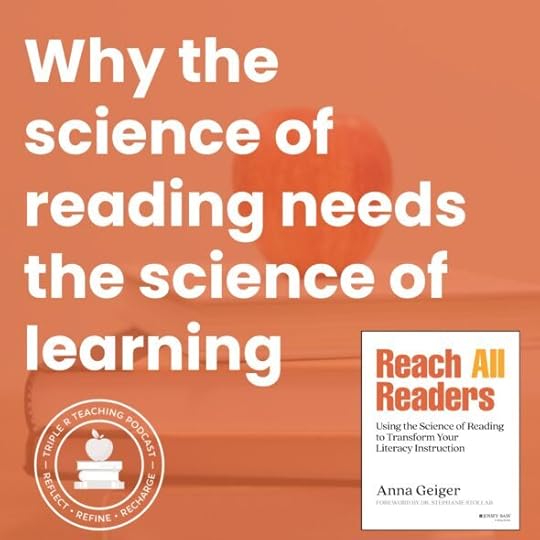 ��TRT Podcast #169: Why the science of reading needs the science of learning
��TRT Podcast #169: Why the science of reading needs the science of learningThe science of reading tells us WHAT to teach – but we also need the science of learning. The science of learning tells us HOW to teach – so that our teaching is more effective and efficient.
Listen to the episode here��Full episode transcriptTranscript
Download
New Tab
Hello, this is Anna Geiger from The Measured Mom. In today's episode I'm kicking off a series of short, to-the-point solo podcast episodes that will serve as a countdown to the release of my new book "Reach All Readers," coming on July 23rd, 2024.
I'd like to start with an endorsement from one of my favorite people, Dr. Pamela Snow. She wrote, "Anna Geiger has managed, with this book, to fill a special gap in the reading instruction library. She has written both from the heart and from a critical, open mind, of her painful but illuminating discoveries about the reading process and how best to support children on their reading journeys. Educators will feel safe, challenged, and informed in equal measure."
I want to thank her for that very kind endorsement.
Now let's get into our first episode of the series, Why The Science of Reading Needs The Science of Learning.
The book is eleven chapters, and in the first chapter I talk about the big picture. I explain the reading wars, discuss some important foundational things we've learned from the science of reading, and then I also explain what led me out of balanced literacy.
Chapter 2 is called The Science of Learning, and in that chapter I explain that the science of reading tells us what to teach, but the science of instruction is how to teach, and that's informed by the science of learning.
The science of learning is everything we've learned from the field of cognitive psychology, and this is so important because when we put the science of learning into practice, our students learn more efficiently and effectively. Think of it as the art of teaching.
One thing we know from the science of learning is that working memory is limited. In other words, we can only keep so many things in our mind as we're trying to learn something new. You may have heard of cognitive load theory by John Sweller, which tells us that teachers need to be aware of the limits of working memory. If we over-complicate our lessons or we don't break things down enough, we overload working memory and our teaching is less effective. Students learn less.
Something else we know from the science of learning is that explicit instruction is a powerful way to teach new skills. Our students don't need to discover everything on their own. Instead, they learn better when we use explicit instruction when teaching new skills, that, "I Do, We Do, You Do" model.
This isn't the teacher just talking at the students and the students listening passively. There's a lot of back and forth, brisk teaching, and quick affirmative and corrective feedback. It's just good teaching.
In this chapter, I break down explicit instruction. I give practical ways that teachers can optimize instructional time, increase opportunities for students to respond, provide feedback, and scaffold instruction.
Reach All Readers is available where books are sold. You can pre-order at Amazon, Barnes and Noble, Bookshop, BAM!, or ThriftBooks. Thanks so much for considering, and I'll talk to you next time!
That's all for this episode of Triple R Teaching. For more educational resources, visit Anna at her home base, themeasuredmom.com, and join our teaching community. We look forward to helping you reflect, refine, and recharge on the next episode of Triple R Teaching.
Scroll back to top
Sign up to receive email updates
Enter your name and email address below and I'll send you periodic updates about the podcast.
powered by
Pre-order my new book and get a FREE bonus!

You’ll love this reader-friendly guide to the science of reading! Learn how to put the research into action so you can reach ALL readers. Pre-order before July 23 and get my Science of Reading Mini-Course – FREE!
PRE-ORDER NOW
The post Why the science of reading needs the science of learning appeared first on The Measured Mom.
3 powerful ways to build fluency with the whole class
 ��TRT Podcast #174: 3 Powerful ways to build fluency with the whole class
��TRT Podcast #174: 3 Powerful ways to build fluency with the whole classThese are simple and powerful fluency routines that you can use throughout the day!��
Listen to the episode here��Full episode transcriptTranscript
Download
New Tab
Hello, this is Anna Geiger from The Measured Mom. In today's episode I'm kicking off a series of short, to-the-point solo podcast episodes that will serve as a countdown to the release of my new book "Reach All Readers," coming on July 23rd, 2024.
I'd like to start with an endorsement from one of my favorite people, Dr. Pamela Snow. She wrote, "Anna Geiger has managed, with this book, to fill a special gap in the reading instruction library. She has written both from the heart and from a critical, open mind, of her painful but illuminating discoveries about the reading process and how best to support children on their reading journeys. Educators will feel safe, challenged, and informed in equal measure."
I want to thank her for that very kind endorsement.
Now let's get into our first episode of the series, Why The Science of Reading Needs The Science of Learning.
The book is eleven chapters, and in the first chapter I talk about the big picture. I explain the reading wars, discuss some important foundational things we've learned from the science of reading, and then I also explain what led me out of balanced literacy.
Chapter 2 is called The Science of Learning, and in that chapter I explain that the science of reading tells us what to teach, but the science of instruction is how to teach, and that's informed by the science of learning.
The science of learning is everything we've learned from the field of cognitive psychology, and this is so important because when we put the science of learning into practice, our students learn more efficiently and effectively. Think of it as the art of teaching.
One thing we know from the science of learning is that working memory is limited. In other words, we can only keep so many things in our mind as we're trying to learn something new. You may have heard of cognitive load theory by John Sweller, which tells us that teachers need to be aware of the limits of working memory. If we over-complicate our lessons or we don't break things down enough, we overload working memory and our teaching is less effective. Students learn less.
Something else we know from the science of learning is that explicit instruction is a powerful way to teach new skills. Our students don't need to discover everything on their own. Instead, they learn better when we use explicit instruction when teaching new skills, that, "I Do, We Do, You Do" model.
This isn't the teacher just talking at the students and the students listening passively. There's a lot of back and forth, brisk teaching, and quick affirmative and corrective feedback. It's just good teaching.
In this chapter, I break down explicit instruction. I give practical ways that teachers can optimize instructional time, increase opportunities for students to respond, provide feedback, and scaffold instruction.
Reach All Readers is available where books are sold. You can pre-order at Amazon, Barnes and Noble, Bookshop, BAM!, or ThriftBooks. Thanks so much for considering, and I'll talk to you next time!
That's all for this episode of Triple R Teaching. For more educational resources, visit Anna at her home base, themeasuredmom.com, and join our teaching community. We look forward to helping you reflect, refine, and recharge on the next episode of Triple R Teaching.
Scroll back to top
Sign up to receive email updates
Enter your name and email address below and I'll send you periodic updates about the podcast.
powered by
Pre-order my new book and get a FREE bonus!

You’ll love this reader-friendly guide to the science of reading! Learn how to put the research into action so you can reach ALL readers. Pre-order before July 23 and get my Science of Reading Mini-Course – FREE!
PRE-ORDER NOW
The post 3 powerful ways to build fluency with the whole class appeared first on The Measured Mom.
Anna Geiger's Blog
- Anna Geiger's profile
- 1 follower



